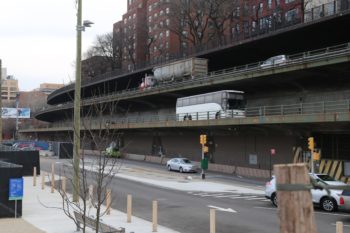
Image Credit: NYC DOT
The plan focuses on immediate monitoring and repairs to allow for more time to plan for the future. On August 4, 2021, Mayor Bill de Blasio and Department of Transportation (DOT) Commissioner Hank Gutman announced a plan to extend the life of the Brooklyn-Queens Expressway (BQE) cantilever for at least 20 years with additional plans for the long-term. The plan is in four parts: preserving the structure; maintenance; expansion in monitoring; and developing a long-term vision.
History
The BQE’s cantilevered bridge has been open since 1954. The triple deck cantilever runs for .4 miles along Furman Street. The structure of the cantilever is dependent on concrete and steel walls that are sunk into the hillside along Furman Street.
After an inspection in 2016, engineers rated the cantilever to be in “poor” or “fair” condition due to water and salt infiltration causing corrosion and weakened steel in the roadways. This raised serious safety concerns, as the City has experienced tragedy due to water and salt infiltration before; in June 1989, a motorist was killed after a 500-pound concrete slab fell on his car from beneath the FDR Drive.
The Mayor’s Office, local elected officials and other stakeholders/interested parties floated several plans to address the BQE, including creating a temporary elevated roadway along the Brooklyn Heights Promenade or diverting traffic away to local routes to allow for construction one lane at a time. In April 2019, Mayor de Blasio formed an expert panel to review and issue recommendations on the BQE reconstruction. The panel included Ross Sandler, the Director of the Center for New York City Law,. The panel issued its final report in January 2020. Some of the recommendations included a rejection of the Promenade proposal, and the urgency to start repair work and monitoring as soon as possible. CityLand’s prior coverage of the panel’s recommendations can be found here.
The City’s Current Plan
The City’s new plan focuses on four main parts that aim to add at least two decades of life for the BQE. The plan focuses on the BQE’s span from Sands Street to Atlantic Avenue in Brooklyn. The current plan does not solve the problem permanently, but hopefully creates more time for future administrations to find a long term solution.
Preserving the Structure
The City’s first part of the plan focuses on preserving the current structure of the BQE. First, the City will implement preservation methods to stop water filtration in an effort to slow down corrosion by improving drainage, adding waterproofing, and addressing the joints.
The City will also follow a recommendation from the Expert Panel and shift the lane markings on the BQE between Atlantic Avenue and the Brooklyn Bridge to change from three lanes in each direction to two. The change for the half-mile segment will begin on August 30th and will result in two wider lanes with a shoulder. The change is expected to reduce the weight along a critical segment of the BQE, and reduce delays, improve traffic, and make the roadway safer. The change will allow for improved entry at Atlantic Avenue.
Maintenance
To preserve and protect the BQE, immediate and ongoing maintenance will be required. The DOT plans to complete its current concrete and rebar repairs on the Hicks Street retaining wall. The work should be complete this year, with work on two deck spans that show faster signs of deterioration to begin next year.
Ongoing maintenance will also be necessary to address issues with water and salt infiltration along the roadway.
Monitoring
Monitoring the health of the BQE is critical in preserving the structure. Sensors have been installed along the BQE, with preliminary results available later this summer. The sensors will monitor how the BQE behaves in real time under traffic. Full results from the sensors should be ready by next spring.
Long-Term Vision
The City plans to engage with affected communities between Staten Island to Queens, and will include businesses and the freight industry to discuss a corridor-wide vision for the BQE.
In May 2021, the Department of Transportation released Delivering New York: A Smart Truck Management Plan for New York City. The plan focuses on how to accommodate the city’s growing freight and delivery needs. As part of the City’s plan to protect the BQE, the City will follow the Delivering New York plan and incentivize off-hour deliveries, cargo bike deliveries and freight consolidation to help alleviate congestion.
The plan also includes working with freight and distribution companies to shift some of the movement of goods from trucks to water or rail, with the goal of eliminating up to 20 million truck miles annually.
Mayor Bill de Blasio stated, “We have the technology, the ideas, and the expertise to save the BQE, and we’re excited to execute this plan. But that’s just the start. New York City can do more than patch up a highway in need of repair – we can use this opportunity to rethink how people, goods, and services move around our city. I look forward to leading that process, and finding fresh ways to use this resource to build a long-term recovery for all of us.”
Carlo A. Scissura, President and CEO of the New York Building Congress and Chair of the BQE Expert Panel stated, “Every day, the safety of Brooklyn Heights residents and commuters hangs in the balance of a mere 1.5-mile stretch of the BQE. We recognized the risks the triple cantilever posed — and the greater needs to reimagine the entire BQE — when the Expert Panel gave its recommendations. Today’s measures, based in part on those findings, is a major step in the long road to ending our dependence on yesterday’s highways, reducing traffic-related emissions and returning open space to communities. We thank and applaud Mayor de Blasio and Commissioner Gutman for taking this historic action.”
By: Veronica Rose (Veronica is the CityLaw fellow and a New York Law School graduate, Class of 2018.)

